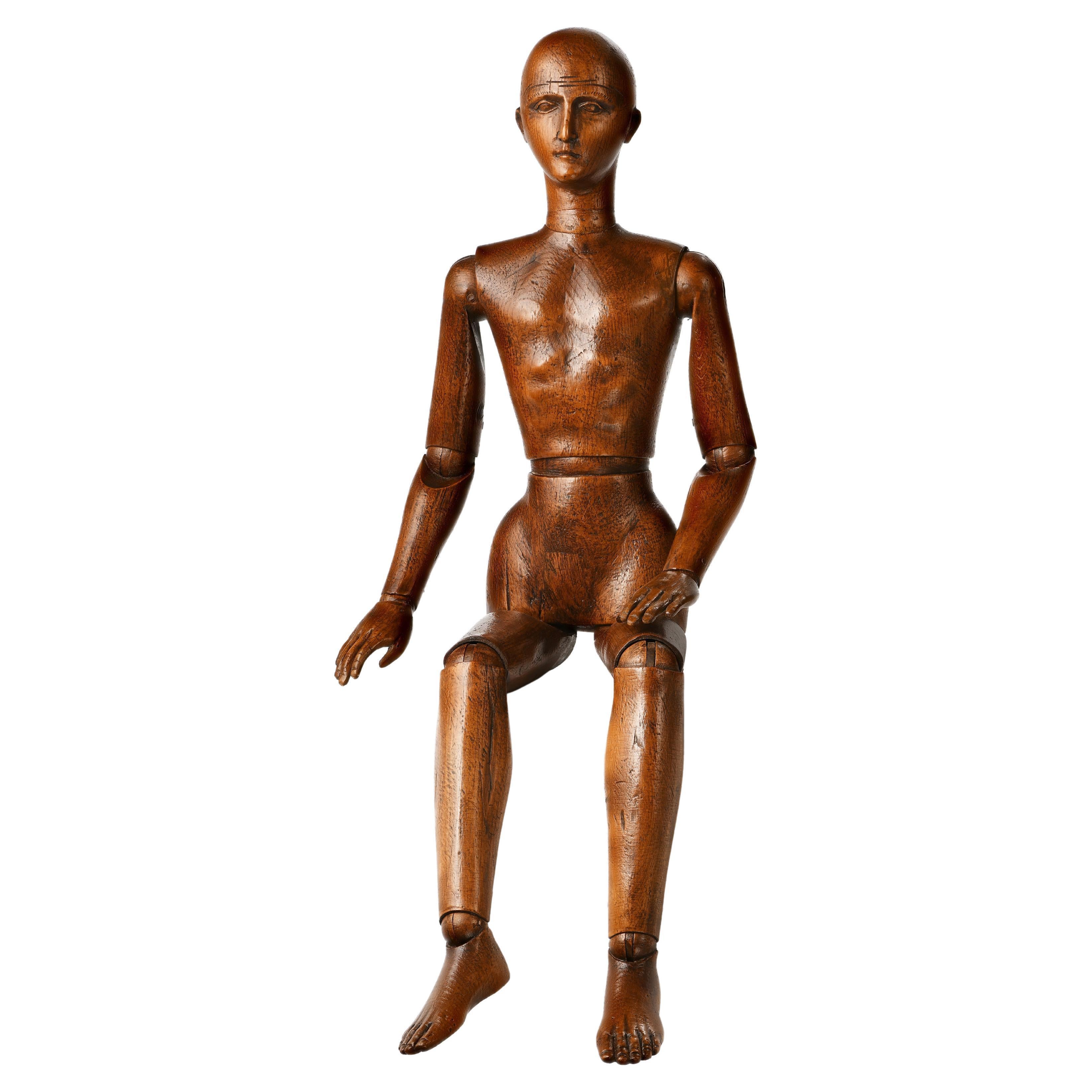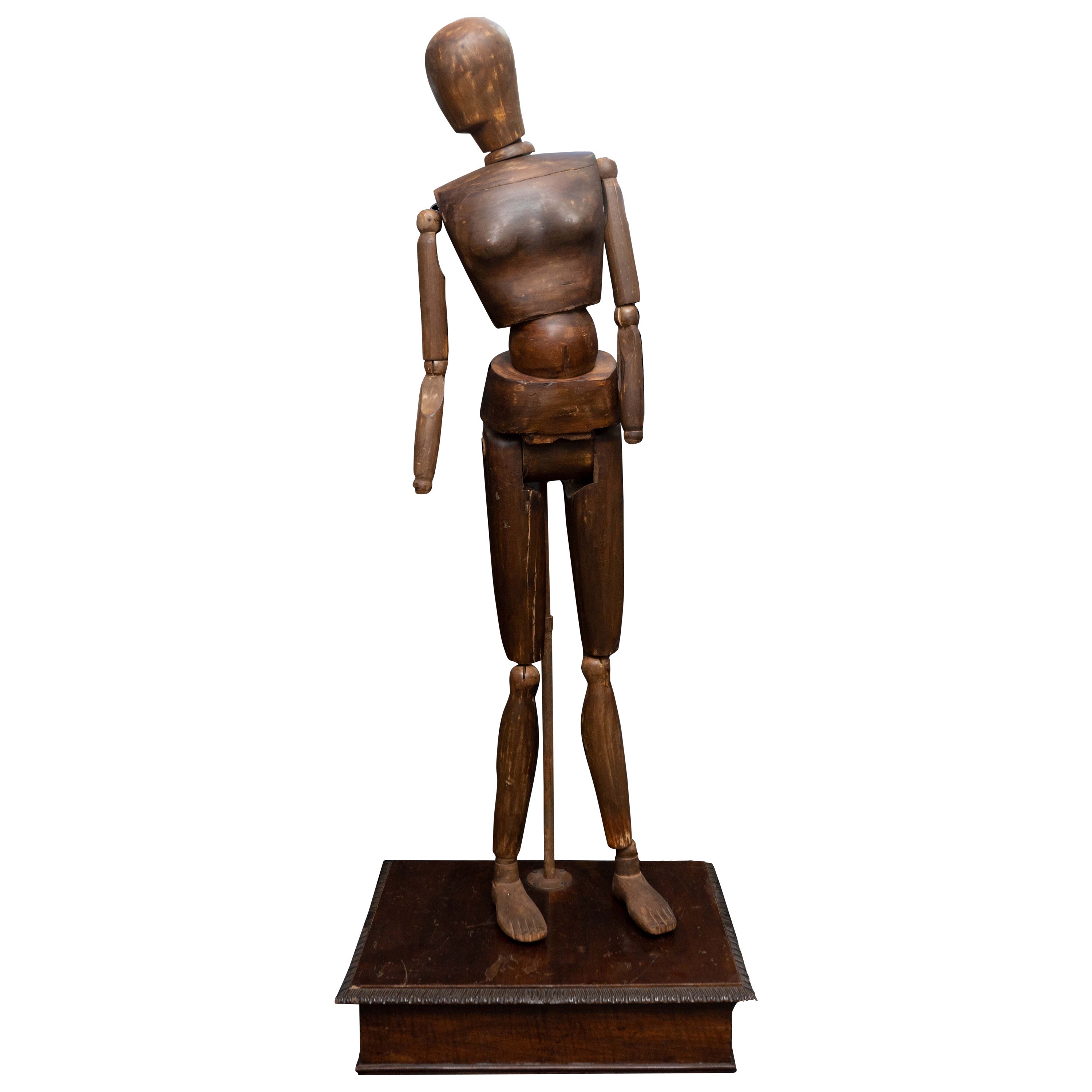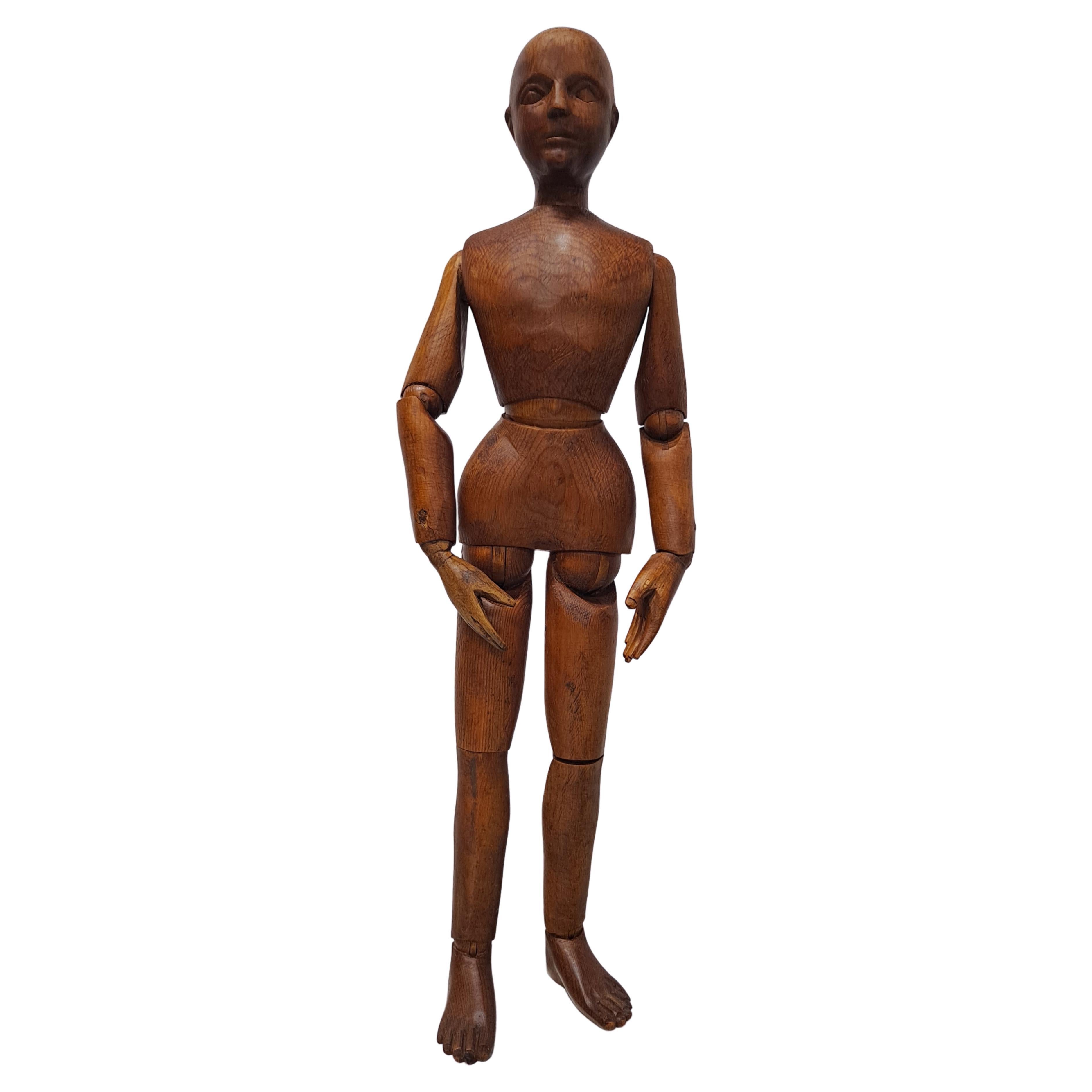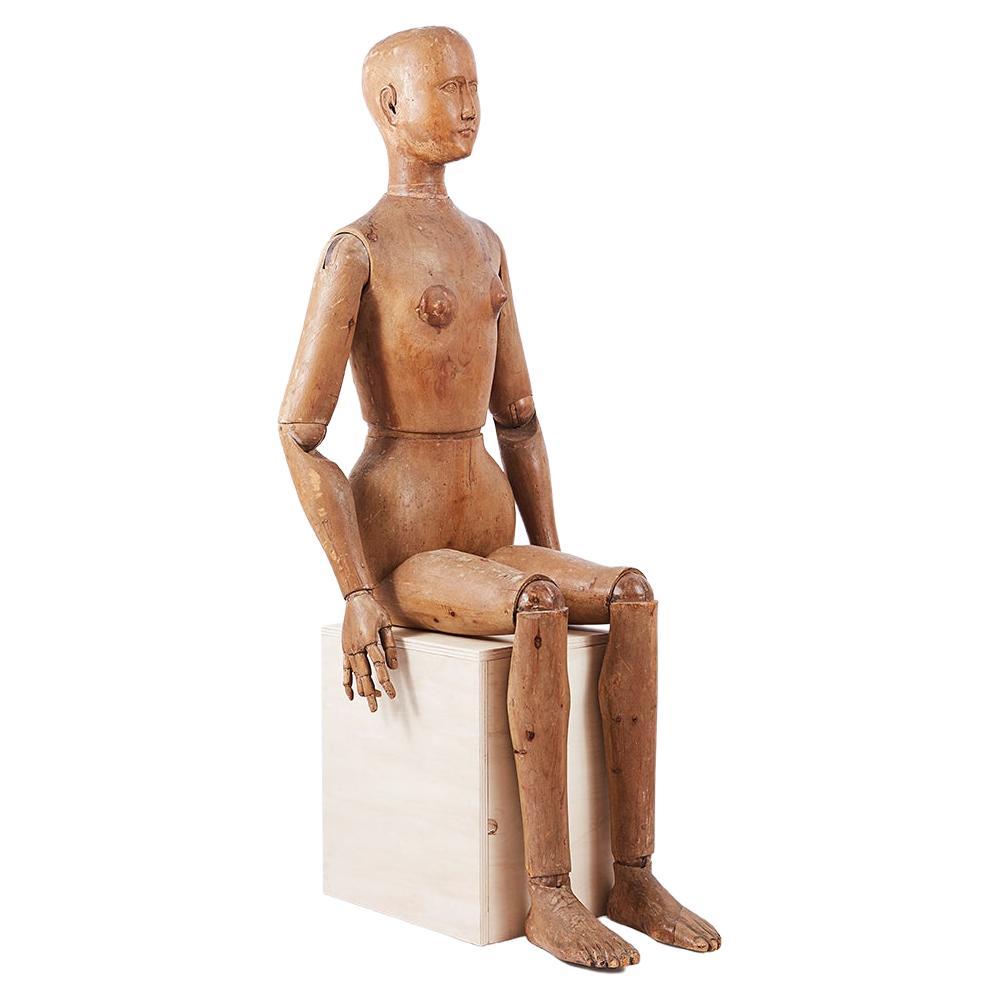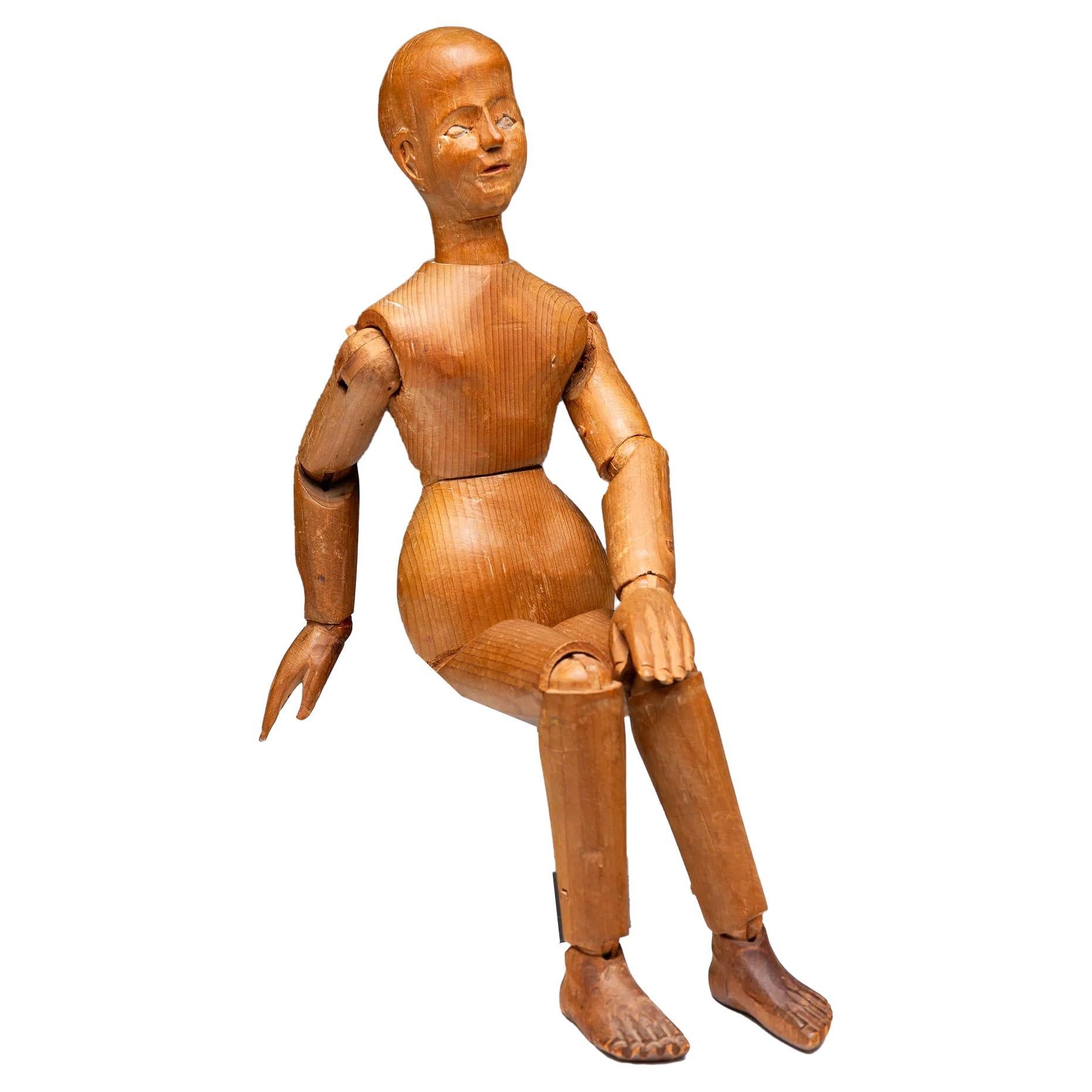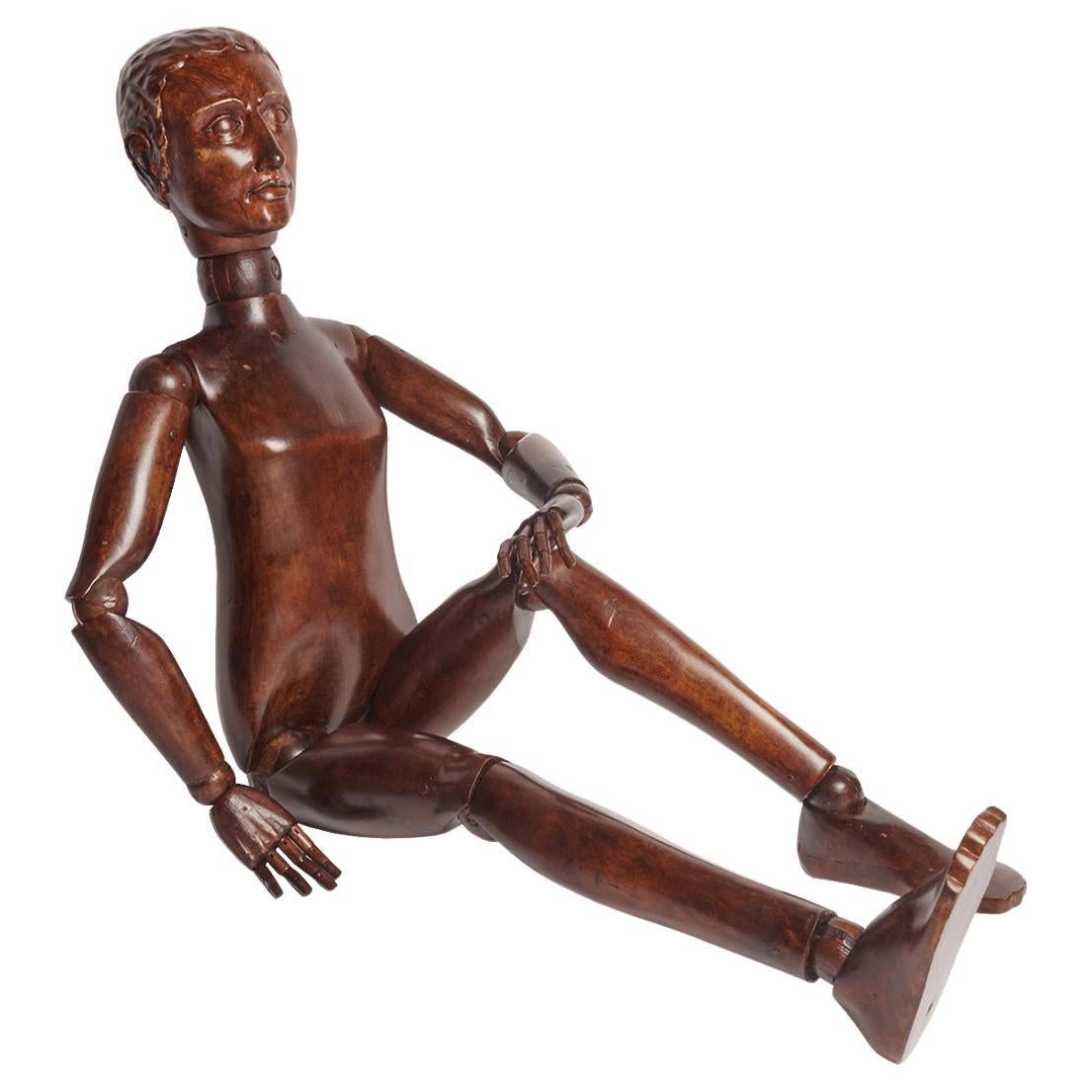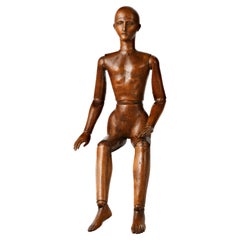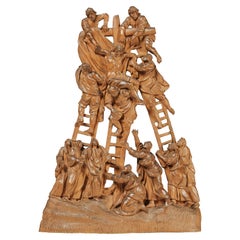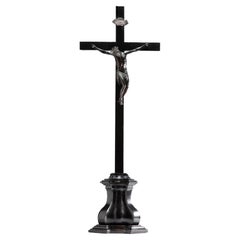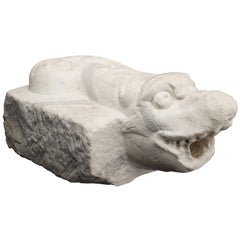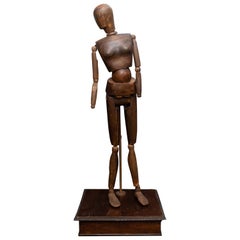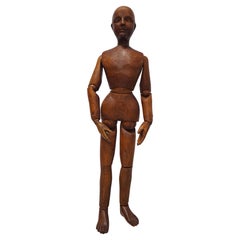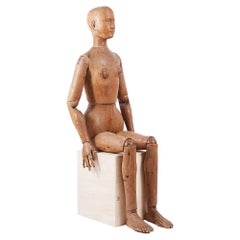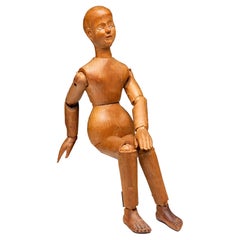Items Similar to Late 19th Century Italian Wood Mannequin, circa 1880
Video Loading
Want more images or videos?
Request additional images or videos from the seller
1 of 22
Late 19th Century Italian Wood Mannequin, circa 1880
$14,298.40
£10,540.44
€12,000
CA$19,575.89
A$21,711.12
CHF 11,401.61
MX$266,627.93
NOK 144,333.60
SEK 136,108.52
DKK 91,323.86
Shipping
Retrieving quote...The 1stDibs Promise:
Authenticity Guarantee,
Money-Back Guarantee,
24-Hour Cancellation
About the Item
Atelier mannequin
graven and carved stone pine wood
Italy, late 19th century
Measures: H 102 cm x 25 cm x 14 cm
H 40.15 in x 9.84 in x 5.51 in
Weight: circa kg 4
State of conservation: good. Small gaps in the ears and behind the right knee. A slit on the nape shows an ancient integration.
The mannequin is sculpted in a realistic manner, with the well-shaped torso musculature and harmoniously shaped limbs. The feet are accurately rendered and the hands are graceful: both are finished with well-defined nails. The face is set in a serious expression, mitigated by the softness of the mouth.
The surface of the wood is soft and "in patina".
The verb "mannequiner" (from which the English word “mannequin” comes) appeared for the first time in 18th century France and is used to describe the act of skillfully draping cloth over a mannequin with a natural effect (MUNRO, J., Silent Partners: Artist and Mannequin from Function to Fetish, Fitzwilliam Museum, Cambridge, October 14, 2014 - January 25, 2015, exhibition catalogue, p. 28).
“... The articulated human figure made of wax or wood was a common tool in artistic practice in Europe from the 16th century. Its indefatigable limbs and silent compliance enabled the artist to study anatomical proportion, fix a pose at will and perfect the depiction of drapery and clothing. In the course of the 19th century, however, the mannequin (or “lay figure” in English) gradually emerged from the studio to become a subject in its own right, at first humorously, then in more troubling ways, playing on the unnerving psychological presence of a figure that was realistic, yet unreal, lifelike, yet lifeless.
Despite the plethora of human effigies and avatars, both virtual and real, that inhabit our 21st century existence, the mannequin continues to fascinate and disturb, an empty vessel for our fears and fantasies ... ” (MUNRO, Jane, op. cit., introduction to the exhibition catalogue).
“As a tool in the artist’s arsenal, however, mannequins were hidden from view and rarely, if ever, included in representations of the artist’s studio – their presence hinting at the laborious act of painting and diminishing the perception of the artist as inspired genius …” (MUNRO, Jane, op. cit., p. 2).
- Dimensions:Height: 40.16 in (102 cm)Width: 9.85 in (25 cm)Depth: 5.52 in (14 cm)
- Style:Other (Of the Period)
- Materials and Techniques:
- Place of Origin:
- Period:
- Date of Manufacture:circa 1880
- Condition:Wear consistent with age and use. Small gaps in the ears and behind the right knee. A slit on the nape shows an ancient integration.
- Seller Location:Milano, IT
- Reference Number:1stDibs: LU4352216817682
About the Seller
4.3
Vetted Professional Seller
Every seller passes strict standards for authenticity and reliability
Established in 1860
1stDibs seller since 2018
21 sales on 1stDibs
Associations
International Confederation of Art and Antique Dealers' Associations
- ShippingRetrieving quote...Shipping from: Milano, Italy
- Return Policy
Authenticity Guarantee
In the unlikely event there’s an issue with an item’s authenticity, contact us within 1 year for a full refund. DetailsMoney-Back Guarantee
If your item is not as described, is damaged in transit, or does not arrive, contact us within 7 days for a full refund. Details24-Hour Cancellation
You have a 24-hour grace period in which to reconsider your purchase, with no questions asked.Vetted Professional Sellers
Our world-class sellers must adhere to strict standards for service and quality, maintaining the integrity of our listings.Price-Match Guarantee
If you find that a seller listed the same item for a lower price elsewhere, we’ll match it.Trusted Global Delivery
Our best-in-class carrier network provides specialized shipping options worldwide, including custom delivery.More From This Seller
View All19th Century Italian Wood Mannequin, Circa 1870-1880
Located in Milano, IT
Mannequin
Sculpted and carved wood
Italy or France, second half of the 19th century.
It measures 25.59 x 6.29 x 3.54 in (65.5 x 16 x 9 cm)
It weighs 2.2 lb circa (1 kg circa)
St...
Category
Antique 1870s Italian Other Figurative Sculptures
Materials
Wood
Ancient Boxwood Micro Carving Deposition, First Half of the 18th Century
Located in Milano, IT
Boxwood micro carving
Deposition
Central Europe, first half of the 18th century
It measures: the sculpture 7.40 x 5.31 x 0.6 in (18.8 x 13.5 x 1.6 cm); w...
Category
Antique 1740s European Baroque Figurative Sculptures
Materials
Boxwood
Crucifix, Bronze, iron, and wood, Lombardy, mid-17th century
Located in Milano, IT
Crucifix
Lombardy, mid-17th century
Bronze, iron, and wood
Sculpture: 33 cm height x 35 cm width x 10 cm depth at the knees;
Cross: 42.12 in height x 19.68 in width (107 cm x 50);
Ba...
Category
Antique Mid-17th Century Italian Baroque Figurative Sculptures
Materials
Bronze, Iron
Italian Ancient Marble Sculpture Fountain, Late 16th Century
Located in Milano, IT
Sea monster
Carrara marble mouth fountain
Italy, late 16th century
It measures 13.8 x 31.5 x 18.9 in (35 x 80 x 48 cm)
State of conservation: some small evident gaps and widespread signs of wear due to outdoor exposure. The gray marks crossing it do not come from restoration, but are rather the natural veins of the marble.
This work has some morphological characteristics typically associated with the iconography of the sea monster: an elongated muzzle, sharp teeth, protruding eyes, elongated ears, and a coiled serpent's tail.
An in-depth series of studies on artistic depictions of the sea monster attempted to verify how this symbol evolved in antiquity in the European and Mediterranean contexts and how it gradually changed its image and function over time. The iconography itself is mutable and imaginative and its history is rich with cultural and artistic exchange, as well as the overlapping of ideas. This occurred so much that it is difficult to accurately pinpoint the "types" that satisfactorily represent its various developments.
However, we can try to summarize the main figures, starting from the biblical Leviathan and the marine creature that swallowed Jonah (in the Christian version, this figure was to become a whale or a "big fish", the “ketos mega”, translation of the Hebrew “dag gadol”). Other specimens ranged from the dragons mentioned in the Iliad (which were winged and had legs) to "ketos” (also from Greek mythology), the terrifying being from whose Latinized name (“cetus”) derives the word "cetacean". See J. Boardman, “Very Like a Whale” - Classical Sea Monsters, in Monsters and Demons in the Ancient and Medieval Worlds, in Papers presented in Honor of Edith Porada, Mainz am Rhein 1987, pp. 73-84).
In Italy the monster underwent yet further variations: it can be found in Etruscan art on the front of some sarcophagi representing the companion of souls, while among the Romans we find the “Pistrice” (cited by Plinio in Naturalis Historia PLIN., Nat., II 9, 8 and by Virgilio in Eneide: VERG., Aen., III, 427), which appeared in the shape of a stylized hippocampus or a very large monstrous cetacean and evolved into a hideous being with a dragon's head and long webbed fins.
During the Middle Ages, the sea monster was the object of new transformations: at this time, it is often winged, the head is stretched like a crocodile, the front legs are often very sharp fins - sometimes real paws - until the image merges with dragons, the typical figures of medieval visionary spirituality widely found throughout Europe (on this topic and much more, see: Baltrušaitis, J., Il Medioevo fantastico. Antichità ed esotismi nell’arte gotica, Gli Adelphi 1997).
In Italy during the 15th and 16th centuries, the revival of classicism - representative of the humanistic and Renaissance periods - led to a different reading of these "creatures". Indeed, the sea monster was also to find widespread use as an isolated decorative motif, especially in numerous fountains and sculptures where dolphins or sea monsters were used as a characterizing element linked to water (on this theme see: Chet Van Duzer, Sea Monsters on Medieval and Renaissance Maps, London, The British library, 2013).
From the morphological point of view, the "sea monsters" of this period are mostly depicted as hybrid figures, in which the body of a mythological or real being (a hippocampus, a sea snake, a dolphin), is joined to a head with a rather indistinct appearance. It was usually characterized by large upright ears, an elongated snout, sharp teeth and globular, protruding eyes; a complex and indefinite figure, both from the symbolic point of view and from that of its genesis.
The work we are examining is placed as a cross between the medieval sea serpent and the Renaissance dolphin, with stylistic features which recall the snake as often used in heraldry (such as the "snake" depicted in the coat of arms of the Visconti - the lords and then dukes of Milan between 1277 and 1447 - and which, for some, may be derived from the representations of the “Pistrice” that swallowed Jonah).
In the search for sources, Renaissance cartography and in particular woodcuts should not be neglected. See for example the monsters of Olaus Magnus, from the editions of the “Historia de gentibus septentrionalibus” (“History of the peoples of the north”) and the natural histories of Conrad Gesner, Ulisse...
Category
Antique 16th Century Italian Renaissance Animal Sculptures
Materials
Carrara Marble
Renaissance Inkwell Calamelli workshop, Italy, Faenza, second half of the 16th
By Virgiliotto Calamelli
Located in Milano, IT
Inkwell
Calamelli workshop (attr.).
Faenza, second half of the 16th century
Height 4.33 in; length 8.07 in; depth 2.95 in (11 cm; 20.5 cm; 7.5 cm)
Weight: 0.800 lb (363 g)
State of conservation: some chipping to the top of the mask around the mouth. Handle glued, without any restorations; minor chips in some raised areas.
This object has the shape of a foot wearing Greek-style footwear, as can be seen in some raised areas. The foot is anatomically modeled with bare toes, while the ankle is partially covered by the footwear. On the heel, there is a small circular handle to support the object. The mouth of the container is shaped like a mask. The interior, completely enameled, suggests that the piece was intended to be used as an inkwell or to contain some other liquid. The base, however, is not enamelled.
The painted decoration, scant and brief, consists of rapid cobalt blue shading between the toes of the foot, with more precise emphasis on the nails. It is accompanied by yellow citrine accents to enhance the forms. The mask is painted with the tip of the brush, to accentuate the tense nature of the eyes and to accentuate their outline. Thin strokes of yellow-orange line the interior of the mouth.
Since the Renaissance, this decoration has been referred to as "compendiaria" and it characterizes the period of production extending from the mid-16th century to approximately the middle of the following century. It significantly influenced tastes at the time. It evolved from the polychrome style "istoriato" and transformed into a new style that "summarized" (compendia), or condensed, the ornamentation of the works into a few colors, placing greater prominence on the shapes. It was often inspired by metal specimens. Since the Renaissance, this decoration has been referred to as "compendiaria" and it characterizes the period of production extending from the mid-16th century to approximately the middle of the following century. It significantly influenced tastes at the time. It evolved from the polychrome style "istoriato" and transformed into a new style that "summarized" (compendia), or condensed, the ornamentation of the works into a few colors, placing greater prominence on the shapes. It was often inspired by metal specimens.
This artwork finds parallels in similar objects all characterized by this refined style and produced in the city of Faenza and other Italian centers starting from the mid-16th century.
The closest comparable example in majolica is a foot acquired by the British Museum in 2011 (inv. 2011, 8008.1). This was previously published by Carmen Ravanelli Guidotti in 1996 and later by Dora Thornton in 2016 during the conference on Renaissance ceramics...
Category
Antique 16th Century Italian Renaissance Inkwells
Materials
Maiolica
Seven Early 19th Century Neoclassical Italian Chairs, Milan circa 1820
Located in Milano, IT
Group of seven chairs
Milan, first quarter of the 19th century
Carved walnut wood, lacquered in gray green and cream and partially gilded
They measure:
height 36.61 in (18.11 in ...
Category
Antique 1810s Italian Neoclassical Chairs
Materials
Walnut
You May Also Like
Early 20th Century Carved Wood Mannequin on Carved Wood Base
Located in New York, NY
A rare and interesting carved wood mannequin resting on a carved wood base from the first part of the 20th century.
Category
Antique Early 1900s American Figurative Sculptures
Materials
Wood
19th Century French Articulated Mannequin
Located in San Francisco, CA
Mid-late 19th century expertly hand carved and fully articulated artist mannequin
Category
Antique Late 19th Century French Primitive Figurative Sculptures
Materials
Walnut
19th Century Italian Female Mannequin Life-Size Artists Lay Figure
Located in Milano, MI
Life-Size Artist Mannequin Italy circa 1870, 19th century articulated lay figure, a carved beech life-size female figure of almost 66 inches, da...
Category
Antique Late 19th Century Italian Figurative Sculptures
Materials
Wood
19th Century Carved Pine Articulated Artists Lay Figure or Mannequin
Located in Chapel Hill, NC
13" Carved pine artists articulated mannequin or lay figure of a male with carved facial features.
Category
Antique Late 19th Century American Folk Art Figurative Sculptures
Materials
Pine
An articulated life-size artist model, Italy end of 19th century.
Located in Milan, IT
Articulated painter's mannequin, depicting a teenage boy, life-size. The mannequin is made of walnut wood, the articulated spheres are made of maple wood. The limbs are fully articul...
Category
Antique Late 19th Century Italian Figurative Sculptures
Materials
Wood, Maple, Walnut
Antique Vintage 19th Century Hand Carved Artist Wooden Articulated Lay Figure
Located in Sale, GB
- A wonderful hand carved artist lay figure, English 19th Century.
- The figure has a subtle understated presence, solid in structure and form, fully articulated yet missing the low...
Category
Antique Early 1900s British Figurative Sculptures
Materials
Beech, Pine
More Ways To Browse
19th Century Wood Italian Furniture
French Mannequin
Wood Torso
Articulated Sculpture
Articulated Wood
Mannequin Furniture
Mannequins
16th Century Italian Wood
Italian Carved Wood Century Figure
Mannequin Hands
Lay Figure
Articulated Figure
Mannequin Sculpture
Antique Painting Tools
Carved Articulated
Nail Sculptures
18th Century Italian Vessel
Wood Articulated Hands
